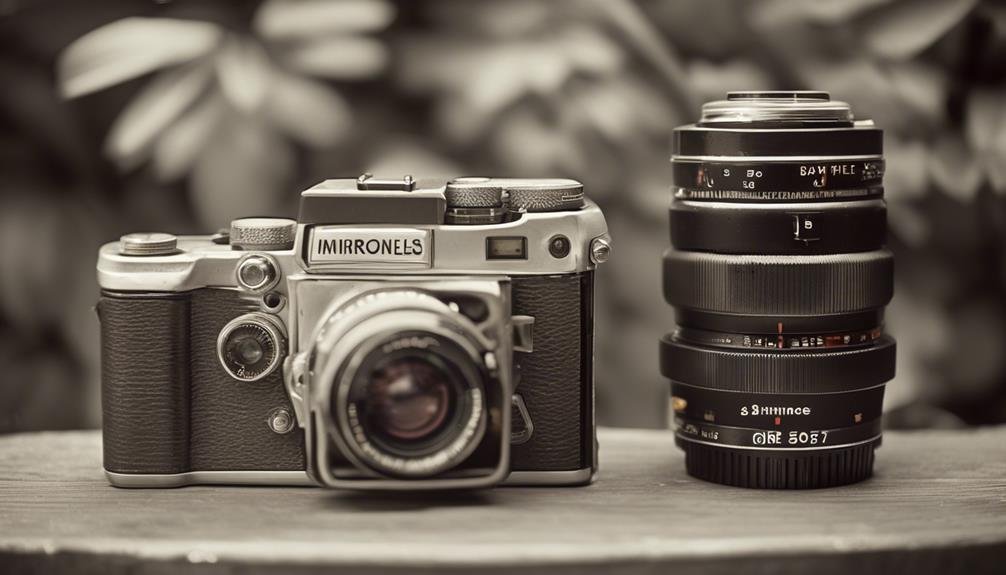
When it comes to capturing the perfect shot, the weight of our gear shouldn't feel like a burden, but rather an extension of our creative vision. As professional photographers, we are constantly seeking the tools that can help us push the boundaries of our craft. In the world of digital photography, the debate between mirrorless and DSLR cameras has been a hot topic, and for good reason. The advancements in mirrorless technology have sparked a revolution, challenging the dominance of DSLRs in the professional arena. From the compact size and weight to the latest autofocus systems and image quality, the mirrorless versus DSLR showdown raises important considerations that can significantly impact our work behind the lens.
Size and Weight
When comparing mirrorless and DSLR cameras, size and weight are significant factors that directly impact the portability and usability of the equipment. The ergonomics and handling of both camera types differ due to their size and weight. Mirrorless cameras, being more compact and lightweight, offer a significant advantage in terms of portability. This makes them suitable for travel and street photography, where a smaller form factor is preferred. Conversely, DSLR cameras, while bulkier and heavier, provide a substantial grip and balance, making them more comfortable for extended shooting sessions, especially with larger lenses.
Furthermore, the presence of an electronic viewfinder in mirrorless cameras contributes to their reduced size, eliminating the need for a bulky optical viewfinder. This not only reduces overall camera dimensions but also impacts the handling and balance. On the other hand, DSLR cameras incorporate an optical viewfinder, adding to their size and weight but providing a different shooting experience, especially for those who prefer an optical viewfinder for composition and focus accuracy.
Autofocus Performance
How does the autofocus performance of mirrorless and DSLR cameras compare in terms of speed and accuracy? When it comes to speed, mirrorless cameras have made significant strides in recent years, often outpacing DSLRs in terms of autofocus speed. This is due to the advancements in on-sensor phase-detection technology, allowing mirrorless cameras to quickly and accurately acquire focus. Additionally, mirrorless cameras have an edge in continuous tracking, thanks to their ability to continuously adjust focus and exposure in real-time during high-speed burst shooting.
In terms of accuracy, both mirrorless and DSLR cameras are highly capable, with each system offering precise autofocus performance. However, mirrorless cameras have shown remarkable improvement in low light performance, leveraging technologies such as improved contrast-detection autofocus and advanced low-light autofocus algorithms. These advancements have narrowed the performance gap between mirrorless and DSLR cameras in challenging lighting conditions.
Image Quality

What factors contribute to the overall image quality produced by mirrorless and DSLR cameras, and how do these factors differ between the two systems? When comparing the image quality of mirrorless and DSLR cameras, several key factors come into play, each influencing the final result in distinct ways:
- Low light performance: Both mirrorless and DSLR cameras vary in their ability to capture high-quality images in low light conditions, with some mirrorless cameras offering impressive performance in this regard due to advanced sensor technology.
- Dynamic range: The dynamic range, or the ability to capture detail in both shadow and highlight areas, differs between mirrorless and DSLR cameras, with some mirrorless models showcasing superior dynamic range capabilities.
- Color accuracy: Mirrorless and DSLR cameras may differ in their color rendering, impacting the accuracy and vibrancy of the images produced.
- Sensor size: The size of the image sensor plays a crucial role in determining image quality, with larger sensors typically offering improved performance, particularly in low light and dynamic range.
Additionally, the presence of in-body image stabilization in some mirrorless cameras can further enhance image quality by reducing the impact of camera shake, resulting in sharper images. These factors collectively contribute to the unique image quality characteristics of both mirrorless and DSLR cameras.
Lens Selection and Adaptability
Lens selection and adaptability play a pivotal role in the versatility and creative potential of both mirrorless and DSLR camera systems, allowing photographers to tailor their equipment to specific shooting needs and artistic preferences. When it comes to lens selection, both systems offer a wide array of options, including native lenses designed specifically for the camera system, manual focus vintage lenses, and third-party lenses. One of the key advantages of mirrorless cameras is their shorter flange distance, which enables greater adaptability to a wide range of lenses, including vintage manual focus lenses. On the other hand, DSLRs have a longer flange distance, which can limit adaptability to certain lens types, but they often have a wider selection of native lenses available. Additionally, both mirrorless and DSLR systems can utilize third-party lenses, providing photographers with even more options to expand their creative potential. The table below summarizes the key considerations for lens selection and adaptability in mirrorless and DSLR camera systems.
| Consideration | Mirrorless Cameras | DSLR Cameras |
|---|---|---|
| Flange Distance | Shorter flange distance, greater adaptability | Longer flange distance, limitations |
| Lens Compatibility | Wide range, including vintage manual focus lenses | More native lens options available |
| Third-party Lenses | Extensive compatibility | Broad range of third-party options available |
Battery Life and Portability

When considering the practical aspects of mirrorless and DSLR camera systems, such as battery life and portability, one can appreciate how these factors contribute to the overall shooting experience. The advancements in battery technology and power management have significantly improved the longevity of mirrorless camera batteries, allowing photographers to shoot for extended periods without constantly swapping batteries. Additionally, the compact nature of mirrorless cameras enhances their overall portability, making them ideal for photographers who need to travel light and remain agile in various shooting environments. The convenience of smaller, lighter batteries and the ability to charge them via USB further adds to the mobility of mirrorless systems, enabling photographers to power up on the go without the need for bulky chargers. Furthermore, the efficient power management of mirrorless cameras ensures that photographers can make the most of their shooting time without being hindered by frequent battery changes, ultimately enhancing the overall shooting experience.
Frequently Asked Questions
Can Mirrorless Cameras Be as Durable and Weather-Sealed as Dslrs?
Yes, mirrorless cameras can be as durable and weather-sealed as DSLRs. Their construction and weather sealing have improved, ensuring reliable performance. The advancements in mirrorless technology have made them a viable option for professional photographers.
How Does the Electronic Viewfinder of a Mirrorless Camera Compare to the Optical Viewfinder of a DSLR in Terms of Clarity and Battery Usage?
In comparing electronic viewfinders of mirrorless cameras to optical viewfinders of DSLRs, we find that the clarity is exceptional in mirrorless, enhancing detail and focus. Additionally, mirrorless cameras generally exhibit efficient battery usage.
Are There Any Specific Types of Photography Where a DSLR Would Outperform a Mirrorless Camera in Terms of Image Quality?
In low light situations and for capturing portraits, a DSLR can outperform a mirrorless camera due to its superior autofocus and larger sensor size. However, for action and sports photography, the mirrorless camera's speed and silent shooting excel.
Can All DSLR Lenses Be Adapted to Mirrorless Cameras, or Are There Limitations and Compatibility Issues?
Yes, not all DSLR lenses can be adapted to mirrorless cameras due to compatibility issues. However, mirrorless cameras offer advantages such as improved autofocus and image stabilization. Understanding lens compatibility is crucial for maximizing the benefits of mirrorless technology.
How Do Mirrorless and DSLR Cameras Compare in Terms of Battery Life When Using Features Like Continuous Shooting or Video Recording?
We've found that mirrorless cameras generally offer better battery life than DSLRs, especially during continuous shooting and video recording. Additionally, their durability and video quality are impressive, making them a top choice for professional photographers.
